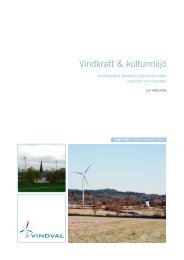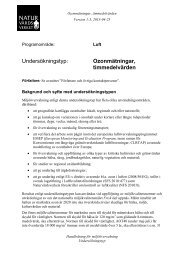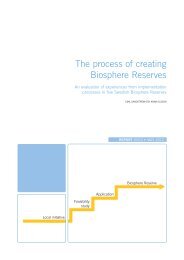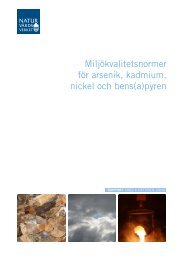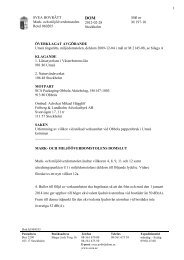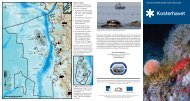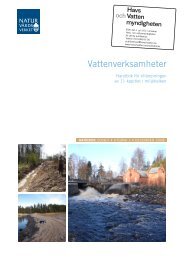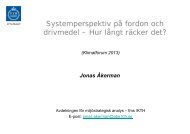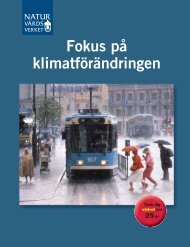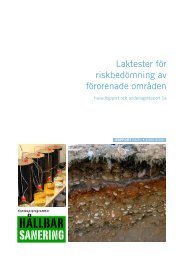Ecosystem services provided by the Baltic Sea ... - Naturvårdsverket
Ecosystem services provided by the Baltic Sea ... - Naturvårdsverket
Ecosystem services provided by the Baltic Sea ... - Naturvårdsverket
You also want an ePaper? Increase the reach of your titles
YUMPU automatically turns print PDFs into web optimized ePapers that Google loves.
SWEDISH ENVIRONMENTAL PROTECTION AGENCY<br />
Report 5873 • <strong>Ecosystem</strong> <strong>services</strong> <strong>provided</strong> <strong>by</strong> <strong>the</strong> <strong>Baltic</strong> <strong>Sea</strong> and Skagerrak<br />
Economic Marine Information<br />
Status, threats and consequences<br />
Status<br />
Sustainability of use<br />
Level of threat<br />
Expected consequences<br />
Good<br />
Sustainable<br />
Low<br />
Limited<br />
There are no threats to <strong>the</strong> provision of wave energy, nor can <strong>the</strong> use of this in any<br />
way diminish its value (i.e. become unsustainable).<br />
Although wave power stations are still rare and mostly at an experimental or development<br />
stage, this energy sector is growing in Sweden and elsewhere. In Wales,<br />
for example, <strong>the</strong> construction of <strong>the</strong> world’s biggest wave energy plant has commenced.<br />
At Islandsberg in Skagerrak a plant is currently set up <strong>by</strong> researchers from<br />
Uppsala University for a full scale test to run from 2008 to 2014. (197). In close<br />
cooperation with researchers at <strong>the</strong> Division for Electricity, Department of Engineering<br />
Sciences, at Uppsala University, <strong>Sea</strong>based Industry AB is planning to build<br />
a pilot plant in Skagerrak. At <strong>the</strong> completion of this plant in 2010, it may include as<br />
many as 2000 generators (using approximately 2 km 2 ) with a maximal effect of 20<br />
MW, thus producing 50 GW/year (198). Although <strong>the</strong> benefits of using energy<br />
from <strong>the</strong> sea as a resource of power are considerable, it is none<strong>the</strong>less easy to imagine<br />
how <strong>the</strong> large-scale distribution of such plants could impact <strong>the</strong> ecosystem<br />
through habitat alteration, possible sound pollution as well as o<strong>the</strong>r disturbances,<br />
particularly during construction. Meanwhile, new artificial underwater environments,<br />
like those presented <strong>by</strong> <strong>the</strong> wave plants, might in fact attract certain species<br />
(providing additional hard surfaces) while naturally offering local protection<br />
against fishing.<br />
Examples of knowledge gaps<br />
There is much to learn about wave energy and its potential. First, technological<br />
improvements are required. Efficiency has to be increased, as well as resistance to<br />
<strong>the</strong> detrimental effects of corrosion and severe wea<strong>the</strong>r conditions. Secondly,<br />
environmental consequences need to be extensively investigated, in <strong>the</strong> same way<br />
as environmental impacts of offshore wind farms are investigated. If wave energy<br />
is to become extensively exploited, areas have to be set aside for this purpose,<br />
based on sound knowledge about <strong>the</strong> distribution of benthic habitats. Finally, largescale<br />
wave power can only become a realistic alternative if gaining economic<br />
strength.<br />
125



